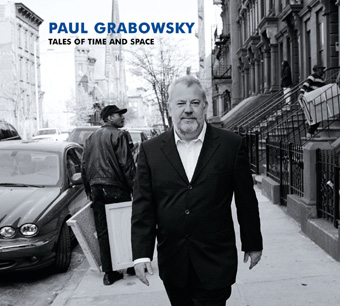The Grabowsky time-space continuum
John Potts

Tales of Time and Space, Paul Grabowsky
The CD cover photo says it all: Paul Grabowsky strolling around Manhattan looking very pleased to be there. And why wouldn’t he be, since he’s there to record 9 of his compositions with such top ranking American jazz musicians as Branford Marsalis, Joe Lovano, Ed Schuller and Jeff Tain Watts (although Marsalis, due to the dreaded ‘contractual obligations’, performs on only 2 tracks). Australian trumpet player Scott Tinkler jets in to complete the group. The sheer logistical effort of assembling these musicians in one time and place is no doubt a tale in itself, but the effort was worth it. This album is many things: a showcase of inventive compositions, a mix of styles and structures and a collection of uniformly excellent performances. Most of all, it is a statement of the possibilities of modern jazz.
The opening track Tailfin defines the album: highly ambitious, technically superb and a study in contrasts. At 9 and a half minutes, Tailfin is by turns blazing and meditative, yet it is the structure of the composition that leaves the final impression. It opens with a kinetic drum solo by Watts, played as if his mission is to compress as much dynamism as possible into 30 seconds. This serves as an opening statement for the album: beginning with a drum solo suggests the focus is to be on the compositions, not 88 keys and one ego.
Tailfin takes many surprise twists. Once the drums have settled down into the middle ground (Watts is never really in the background), a theme is played by Marsalis on soprano sax, accompanied by Tinkler on trumpet and toilet plunger (bought, according to the engaging album notes, from a Chelsea hardware store). This theme is a little disorienting: a fast vertiginous round that’s part folk dance and part Ornette Coleman. Once it’s done, Tinkler launches into an incendiary trumpet solo, backed only by the tumultuous drums. The trumpet is pure brazen energy, delivered in a clear tone that rides above and across the drumming. After this energy burst, the tune slows down, turning lyrical and reaching almost a still point. Grabowsky takes over the composition with melancholy piano lines, dropping to the lower register before stepping up to a chordal progression. This rhythmic development attracts the drums, which build up momentum again, this time summoning Marsalis. Now the composition is in a new phase, with Marsalis unwinding over drums and bass, while Grabowsky re-enters with those chords.
Marsalis takes the tune apart, in the decontructivist manner pioneered by Coltrane. Jack Kerouac described Miles’ bop trumpet as “speaking in long sentences like Marcel Proust”; Coltrane liked to play the same sentence over and over, from different angles until it was exhausted, an avant-garde re-writing of the Proustian sentence. This is what Marsalis does here, speaking one long soprano sentence upwards, downwards and sideways, building to a peak as the other musicians add their support. Then a return to the vertiginous theme, some stabs in unison like exclamation marks, and the trumpet trails off and upwards to end the composition. All this on the opening track: no wonder Marsalis cries “Great Caesar’s ghost!” when it’s over.
After this delirious ride, the album settles down a little but loses nothing in ambition. Tales of Time and Space is just that; a sweep across music history and cultural difference. Styles and methods are taken from a startlingly wide range of sources, from 17th century Spanish dance to Silverchair. But this is no postmodern pastiche. The various source materials are absorbed into Grabowsky’s jazz compositions, adding distinctive flavours but never spoiling the texture or status of the works. On a larger scale and at a different time, Duke Ellington did the same with his great compositions.
Sideshow Sarabande, the second track, is a jazz version of the Baroque triple-time dance, featuring Grabowsky in buoyant mood. Silverland is a sprightly tribute to the Aussie rock band, with bouncy piano, silvery trumpet, and a crescendo embracing the grunge-pop cadences of its inspiration. Angel is an overtly lyrical turn, featuring the album’s most beautiful melody. A collective commitment to simplicity allows the musicians to explore the lyricism while avoiding sentimentality, especially in the solos by Tinkler and Lovano on tenor sax.
The best—or at least most memorable—of the album’s tracks are these first 4; the second half of the CD does not quite match the first. Perhaps Grabowsky the pianist could have showcased himself on a solo or duet track to add formal variety. But these are minor quibbles. On this album the compositions and ensemble playing are the thing. The many times and spaces subsumed into this recording produce a here and now that is truly exciting to hear.
Paul Grabowsky, Tales of Time and Space, Warner CD 2004
RealTime issue #61 June-July 2004 pg. 52






